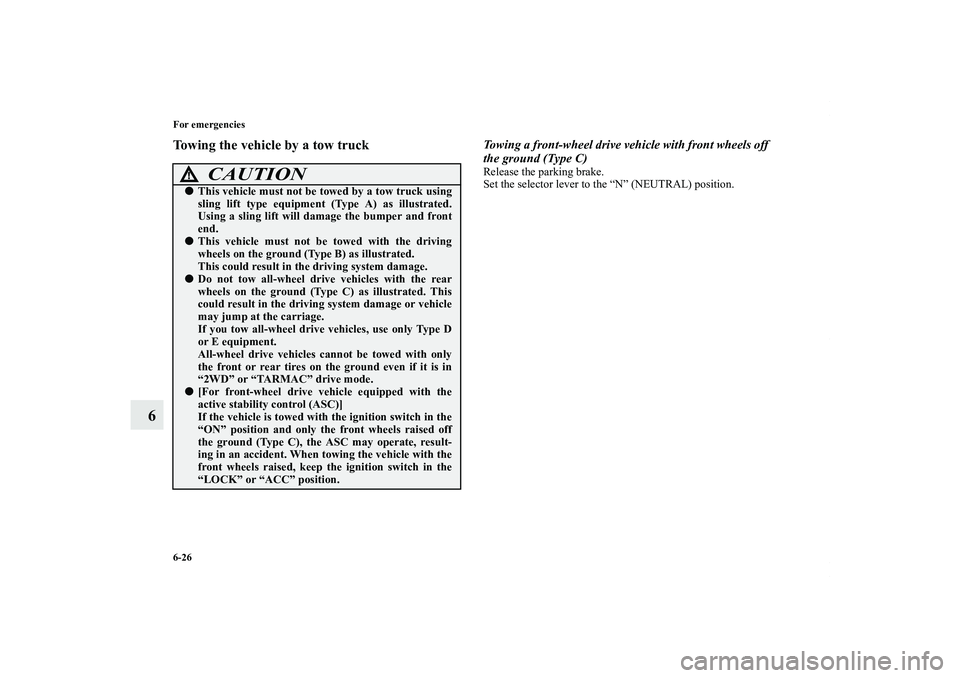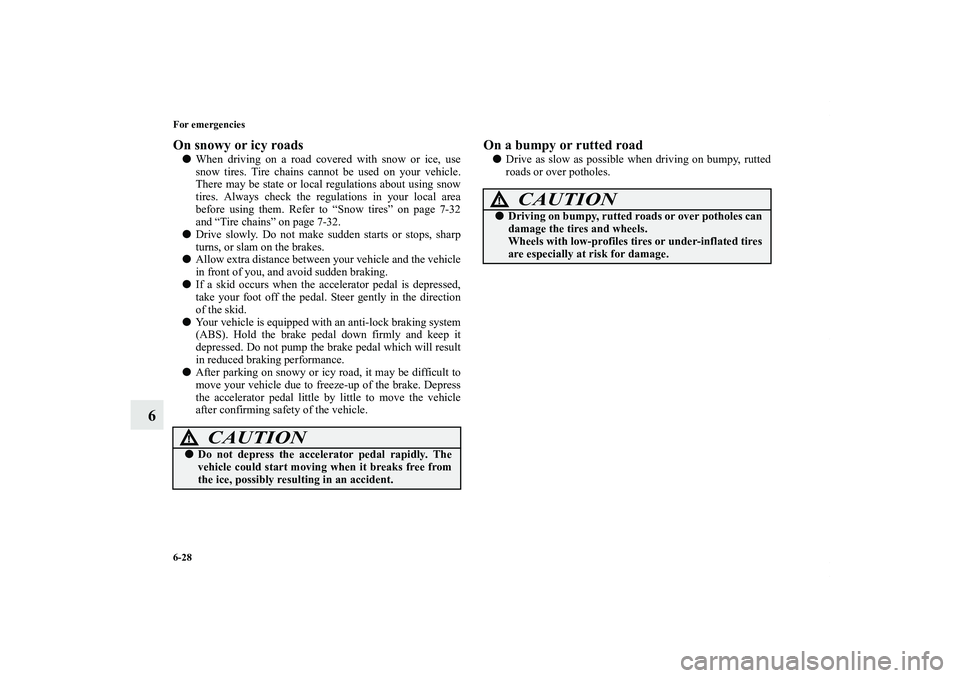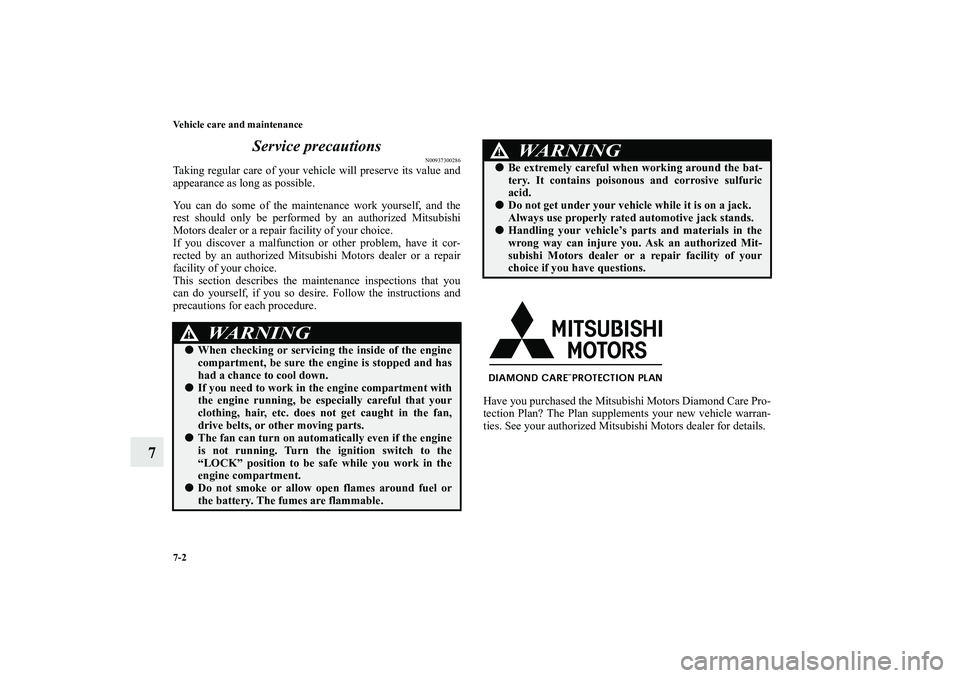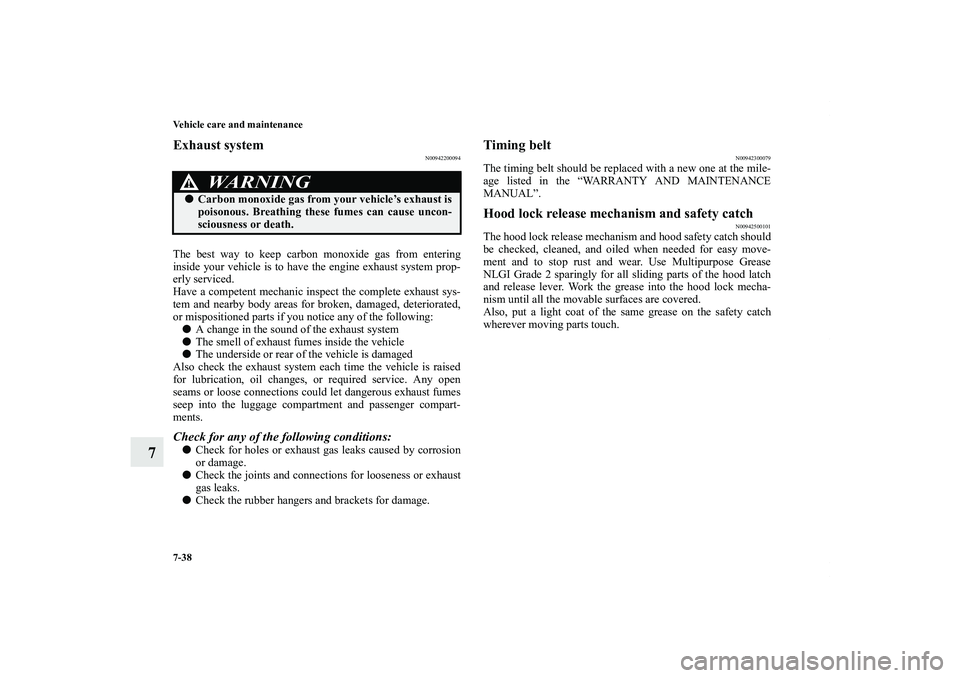Page 594 of 714
For emergencies
6-21
6
8. Lower the vehicle slowly until the tire touches the ground,
by rotating the wheel nut wrench counterclockwise.9. Tighten the nuts in the order shown in the illustration until
each nut has been tightened to the torque listed here.
65 to 80 ft-lb (88 to 108 N•m)
10. Lower the jack all the way and remove it.
CAUTION
!�Never use your foot or a pipe extension to apply
added force to the wheel nut wrench when tighten-
ing the wheel nuts. If you do so, you can over-tighten
the wheel nuts and damage the wheel, wheel nuts
and hub bolts.
BK0138000US.book 21 ページ 2011年4月13日 水曜日 午前11時17分
Page 599 of 714

6-26 For emergencies
6
Towing the vehicle by a tow truck
Towing a front-wheel drive vehicle with front wheels off
the ground (Type C)Release the parking brake.
Set the selector lever to the “N” (NEUTRAL) position.
CAUTION
!�This vehicle must not be towed by a tow truck using
sling lift type equipment (Type A) as illustrated.
Using a sling lift will damage the bumper and front
end.�This vehicle must not be towed with the driving
wheels on the ground (Type B) as illustrated.
This could result in the driving system damage.�Do not tow all-wheel drive vehicles with the rear
wheels on the ground (Type C) as illustrated. This
could result in the driving system damage or vehicle
may jump at the carriage.
If you tow all-wheel drive vehicles, use only Type D
or E equipment.
All-wheel drive vehicles cannot be towed with only
the front or rear tires on the ground even if it is in
“2WD” or “TARMAC” drive mode.�[For front-wheel drive vehicle equipped with the
active stability control (ASC)]
If the vehicle is towed with the ignition switch in the
“ON” position and only the front wheels raised off
the ground (Type C), the ASC may operate, result-
ing in an accident. When towing the vehicle with the
front wheels raised, keep the ignition switch in the
“LOCK” or “ACC” position.
BK0138000US.book 26 ページ 2011年4月13日 水曜日 午前11時17分
Page 601 of 714

6-28 For emergencies
6
On snowy or icy roads�When driving on a road covered with snow or ice, use
snow tires. Tire chains cannot be used on your vehicle.
There may be state or local regulations about using snow
tires. Always check the regulations in your local area
before using them. Refer to “Snow tires” on page 7-32
and “Tire chains” on page 7-32.
�Drive slowly. Do not make sudden starts or stops, sharp
turns, or slam on the brakes.
�Allow extra distance between your vehicle and the vehicle
in front of you, and avoid sudden braking.
�If a skid occurs when the accelerator pedal is depressed,
take your foot off the pedal. Steer gently in the direction
of the skid.
�Your vehicle is equipped with an anti-lock braking system
(ABS). Hold the brake pedal down firmly and keep it
depressed. Do not pump the brake pedal which will result
in reduced braking performance.
�After parking on snowy or icy road, it may be difficult to
move your vehicle due to freeze-up of the brake. Depress
the accelerator pedal little by little to move the vehicle
after confirming safety of the vehicle.
On a bumpy or rutted road�Drive as slow as possible when driving on bumpy, rutted
roads or over potholes.
CAUTION
!�Do not depress the accelerator pedal rapidly. The
vehicle could start moving when it breaks free from
the ice, possibly resulting in an accident.
CAUTION
!�Driving on bumpy, rutted roads or over potholes can
damage the tires and wheels.
Wheels with low-profiles tires or under-inflated tires
are especially at risk for damage.
BK0138000US.book 28 ページ 2011年4月13日 水曜日 午前11時17分
Page 603 of 714

7-2 Vehicle care and maintenance
7Service precautions
N00937300286
Taking regular care of your vehicle will preserve its value and
appearance as long as possible.
You can do some of the maintenance work yourself, and the
rest should only be performed by an authorized Mitsubishi
Motors dealer or a repair facility of your choice.
If you discover a malfunction or other problem, have it cor-
rected by an authorized Mitsubishi Motors dealer or a repair
facility of your choice.
This section describes the maintenance inspections that you
can do yourself, if you so desire. Follow the instructions and
precautions for each procedure.
Have you purchased the Mitsubishi Motors Diamond Care Pro-
tection Plan? The Plan supplements your new vehicle warran-
ties. See your authorized Mitsubishi Motors dealer for details.
WA R N I N G
!�When checking or servicing the inside of the engine
compartment, be sure the engine is stopped and has
had a chance to cool down.�If you need to work in the engine compartment with
the engine running, be especially careful that your
clothing, hair, etc. does not get caught in the fan,
drive belts, or other moving parts.�The fan can turn on automatically even if the engine
is not running. Turn the ignition switch to the
“LOCK” position to be safe while you work in the
engine compartment.�Do not smoke or allow open flames around fuel or
the battery. The fumes are flammable.
�Be extremely careful when working around the bat-
tery. It contains poisonous and corrosive sulfuric
acid.�Do not get under your vehicle while it is on a jack.
Always use properly rated automotive jack stands.�Handling your vehicle’s parts and materials in the
wrong way can injure you. Ask an authorized Mit-
subishi Motors dealer or a repair facility of your
choice if you have questions.
WA R N I N G
!
BK0138000US.book 2 ページ 2011年4月13日 水曜日 午前11時17分
Page 605 of 714
7-4 Vehicle care and maintenance
7Engine hood
N00937500507
To openUse the engine hood release lever (located under the instrument
panel near the driver’s door) to unlock the engine hood.
Pull the lever toward you to release the engine hood latch.Release the lever and lift the engine hood.
NOTE�To prevent damage to the engine hood and wipers, make
sure the wipers are at resting position when you open the
engine hood.
WA R N I N G
!�Never use the release lever to unlatch the engine
hood while the vehicle is in motion.�Do not drive your vehicle unless the engine hood is
locked.
BK0138000US.book 4 ページ 2011年4月13日 水曜日 午前11時17分
Page 639 of 714

7-38 Vehicle care and maintenance
7
Exhaust system
N00942200094
The best way to keep carbon monoxide gas from entering
inside your vehicle is to have the engine exhaust system prop-
erly serviced.
Have a competent mechanic inspect the complete exhaust sys-
tem and nearby body areas for broken, damaged, deteriorated,
or mispositioned parts if you notice any of the following:
�A change in the sound of the exhaust system
�The smell of exhaust fumes inside the vehicle
�The underside or rear of the vehicle is damaged
Also check the exhaust system each time the vehicle is raised
for lubrication, oil changes, or required service. Any open
seams or loose connections could let dangerous exhaust fumes
seep into the luggage compartment and passenger compart-
ments.Check for any of the following conditions:�Check for holes or exhaust gas leaks caused by corrosion
or damage.
�Check the joints and connections for looseness or exhaust
gas leaks.
�Check the rubber hangers and brackets for damage.
Timing belt
N00942300079
The timing belt should be replaced with a new one at the mile-
age listed in the “WARRANTY AND MAINTENANCE
MANUAL”.Hood lock release mechanism and safety catch
N00942500101
The hood lock release mechanism and hood safety catch should
be checked, cleaned, and oiled when needed for easy move-
ment and to stop rust and wear. Use Multipurpose Grease
NLGI Grade 2 sparingly for all sliding parts of the hood latch
and release lever. Work the grease into the hood lock mecha-
nism until all the movable surfaces are covered.
Also, put a light coat of the same grease on the safety catch
wherever moving parts touch.
WA R N I N G
!�Carbon monoxide gas from your vehicle’s exhaust is
poisonous. Breathing these fumes can cause uncon-
sciousness or death.
BK0138000US.book 38 ページ 2011年4月13日 水曜日 午前11時17分
Page 641 of 714
7-40 Vehicle care and maintenance
7Fuses
N00942800827
Fuse block locationTo prevent damage to the electrical system from short-circuit-
ing or overloading, each individual circuit is equipped with a
fuse. The fuse blocks are located in the passenger compartment
and in the engine compartment.Passenger compartmentThe fuse blocks in the passenger compartment are located
behind the personal compartment.Main fuse block
1. Open the personal compartment and pull to remove it.A- Main fuse block
B- Sub fuse block
BK0138000US.book 40 ページ 2011年4月13日 水曜日 午前11時17分
Page 642 of 714
Vehicle care and maintenance
7-41
7
2. To put back the personal compartment, line up the per-
sonal compartment hook (C) with the clamp (D) on the
instrument panel and push the personal compartment back
in. Sub fuse block
1. Remove the personal compartment in the same way that
you would with the main fuse block.
2. Use the fuse remover to pry loose the 2 clips (E) on the
bottom cover.
The remover is in the fuse block in the engine compart-
ment.
Refer to “Fuse replacement” on page 7-46.
NOTE�When finished, be sure to return the remover to the fuse
block in the engine compartment.
BK0138000US.book 41 ページ 2011年4月13日 水曜日 午前11時17分